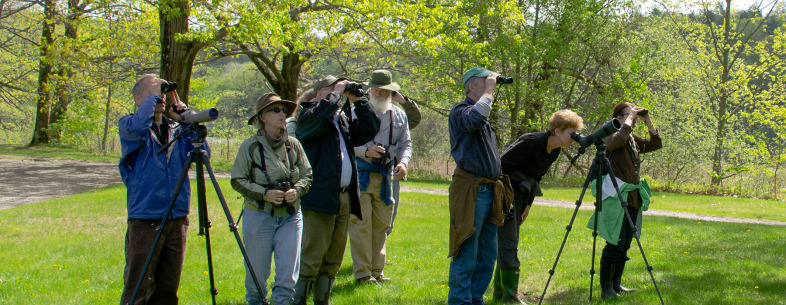With spring finally here, wildlife enthusiasts are dusting off their binoculars and heading out looking for birds as they migrate into Vermont from points south. While there are opportunities to see birds even in a backyard, some of the Vermont’s best bird-watching opportunities are on the state’s 90 wildlife management areas, or WMAs.
Wildlife management areas are owned by the Vermont Fish & Wildlife Department and are managed for wildlife habitat and for wildlife-based recreation such as hunting, fishing and bird-watching. And as this list shows, there is likely one near you. You can even search the Vermont eBird hotspot tool to see what is being seen at a particular WMA, print a bird checklist, and more.
Paul Hamelin is the Fish & Wildlife Department biologist who coordinates habitat management and access on Vermont’s WMAs. He believes that while there are opportunities for birding at every WMA, a few stick out to him as particularly good places to spot birds.
“Dead Creek WMA in Addison is perhaps the crown jewel of birding in Vermont,” said Hamelin. “An incredible two hundred bird species can be found there, particularly ducks, shorebirds, and hawks. And each spring and fall, thousands of snow geese touch down at Dead Creek on their annual migration.”
Dead Creek has trails and a lookout platform, but Hamelin suggests a canoe or kayak for best access. A new Dead Creek Visitor Center is scheduled to open this October. Check the Vermont eBird hotspots to learn what is being seen: Dead Creek WMA – Brylea Access and Dead Creek WMA IBA.
On the other side of the state, Hamelin recommends Wenlock WMA in Ferdinand, which has all of the endless bogs and boreal forests that the Northeast Kingdom is known for in a tidy, 2,000-acre package. He recommends people check out the new boardwalk and viewing platform at Moose Bog. Visit the Vermont eBird Moose Bog hotspot to explore more.
“Wenlock is a great place for birders to check off four of Vermont’s premiere boreal bird species; the Canada jay, boreal chickadee, black-backed woodpecker, and state-endangered spruce grouse,” said Hamelin. “You might also get lucky and see another state endangered bird, the rusty blackbird, which is sadly becoming increasingly rare in the northeastern U.S.”
For a rare bird sighting in southern Vermont, Hamelin recommends Birdseye Wildlife Management Area in the towns of Ira, Castleton, and Poultney. This WMA, formerly known as Bird Mountain, recently increased by nearly 3,000 acres. At the center of the WMA is Birdseye Mountain, a large hunk of rocky cliffs that are home to the world’s fastest bird, the peregrine falcon, which can dive to over 200 mph. Check out the Vermont eBird hotspot to learn more about the birds here.
“Peregrine falcons are the star of the show at the Birdseye, but there are also fantastic opportunities to see and hear warblers, thrushes, and sparrows,” said Hamelin. “After the peregrine nesting season is complete in mid-August, there is a well-worn goat path that takes brave souls up the rocky slopes of the cliff face for fantastic views of the newly conserved ridgelines.”
Vermont’s wildlife management areas can be found in nearly every corner of the state and there are birding opportunities at every one of them this time of year. Birding is inexpensive and is an easy activity to get started in. Hamelin recommends people check out their nearest wildlife management area this spring.
Access to Vermont’s wildlife management areas is free, but birders can help the Fish & Wildlife Department in its effort to conserve habitat for birds and other species by purchasing an annual Vermont Habitat Stamp, available for $15 on the department’s website at vtfishandwildlife.com. There is also additional information on birding opportunities on wildlife management areas on the Fish & Wildlife Department’s website.


Totally agree. While turkey hunting this week at Podunk WMA I’ve heard a pre-dawn chorus of Wood Thrush and Winter Wrens.
Please be aware that May is spring turkey season (shooting hours are .5 hr before sunrise to noon). Please be safe and wear orange.